These crispy and juicy Napa Cabbage Gyoza with miso dipping sauce are bursting with flavor and have an amazing, balanced texture. The mild and sweet napa cabbage perfectly complements the miso-seasoned pork filling. Make a batch and freeze now!
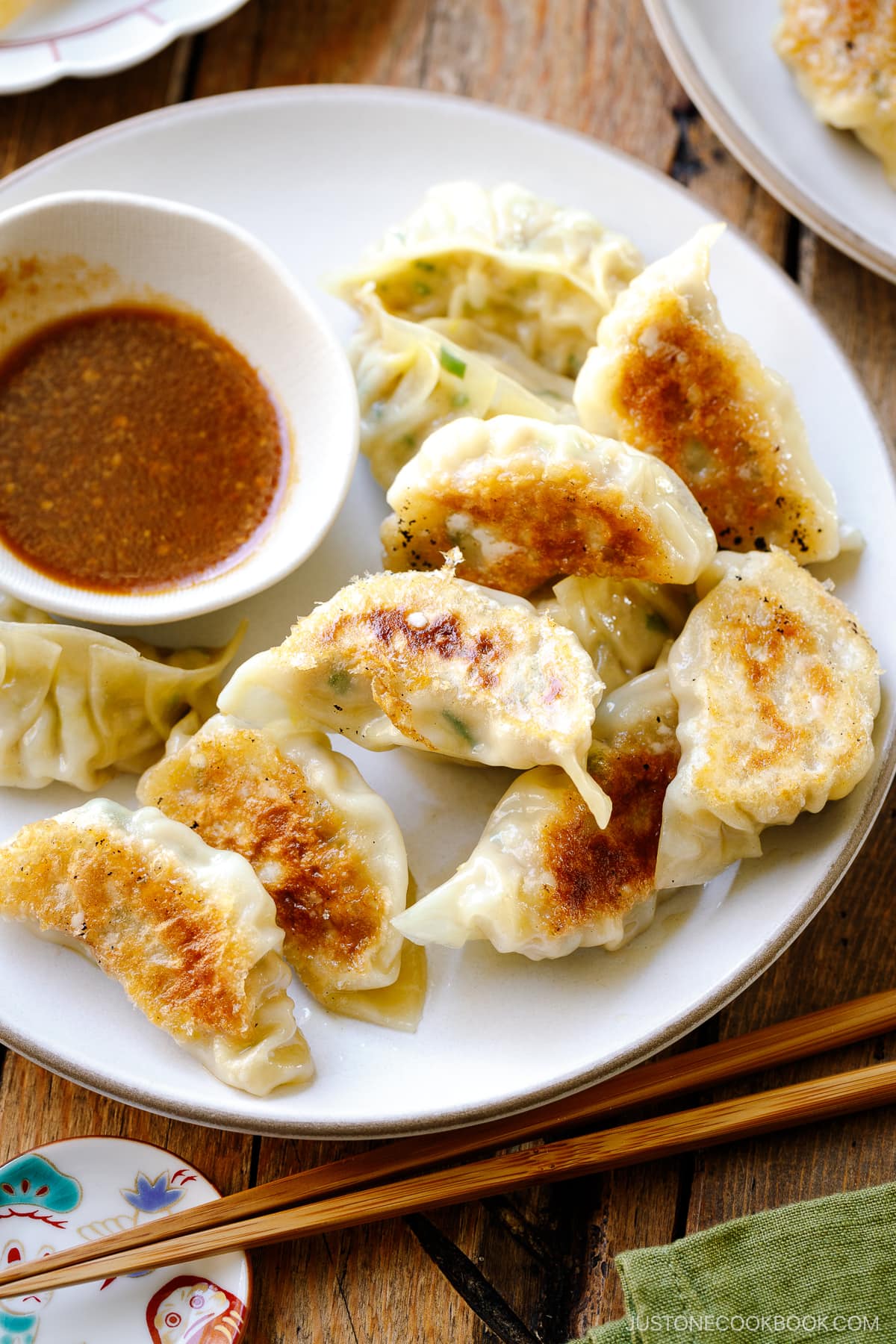

If you love dumplings but haven’t tried making gyoza (Japanese pan-fried potstickers) at home, please mark it down on your bucket to-cook list. Even though homemade gyoza require some time to make, you’ll find them totally worth the time and effort! Good dumplings are homemade!
On the blog, you’ll find my Most Popular Classic Gyoza Recipe, Vegetable Gyoza stuffed with tofu and a mixture of vegetables, and the ultra-crispy Gyoza with Wings. Today, we’ll make another delicious version: Napa Cabbage Gyoza!
I serve these light yet filling gyoza with a savory miso dipping sauce. They are so good that my family devours them instantly!
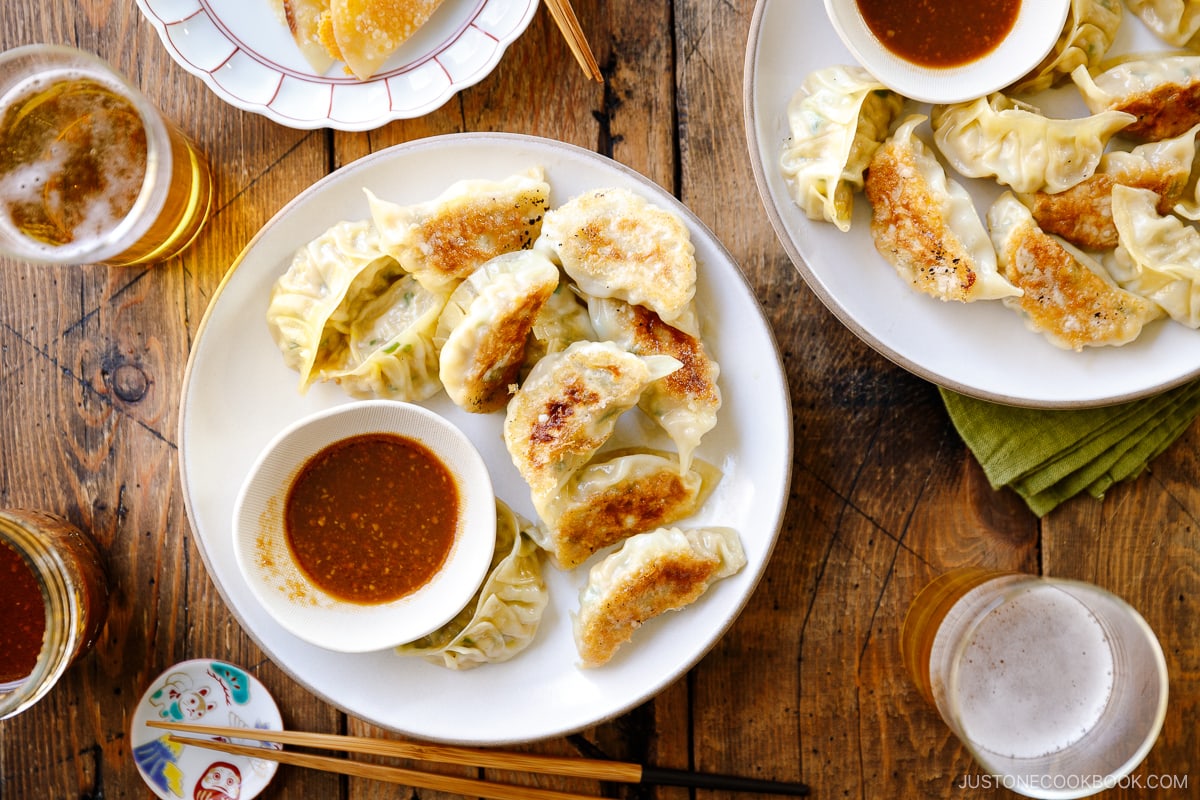

Why You’ll Love This Recipe
- The gyoza filling requires simple ingredients with a good mix of vegetables and meat.
- It’s a fabulous way to use up your leftover napa cabbage!
- Freezer-friendly: Make a big batch and freeze them. They can easily be pan-fried whenever you need dumplings.
- A versatile dish to serve as a crowd-pleasing appetizer, a main or side dish, or as part of your bento.
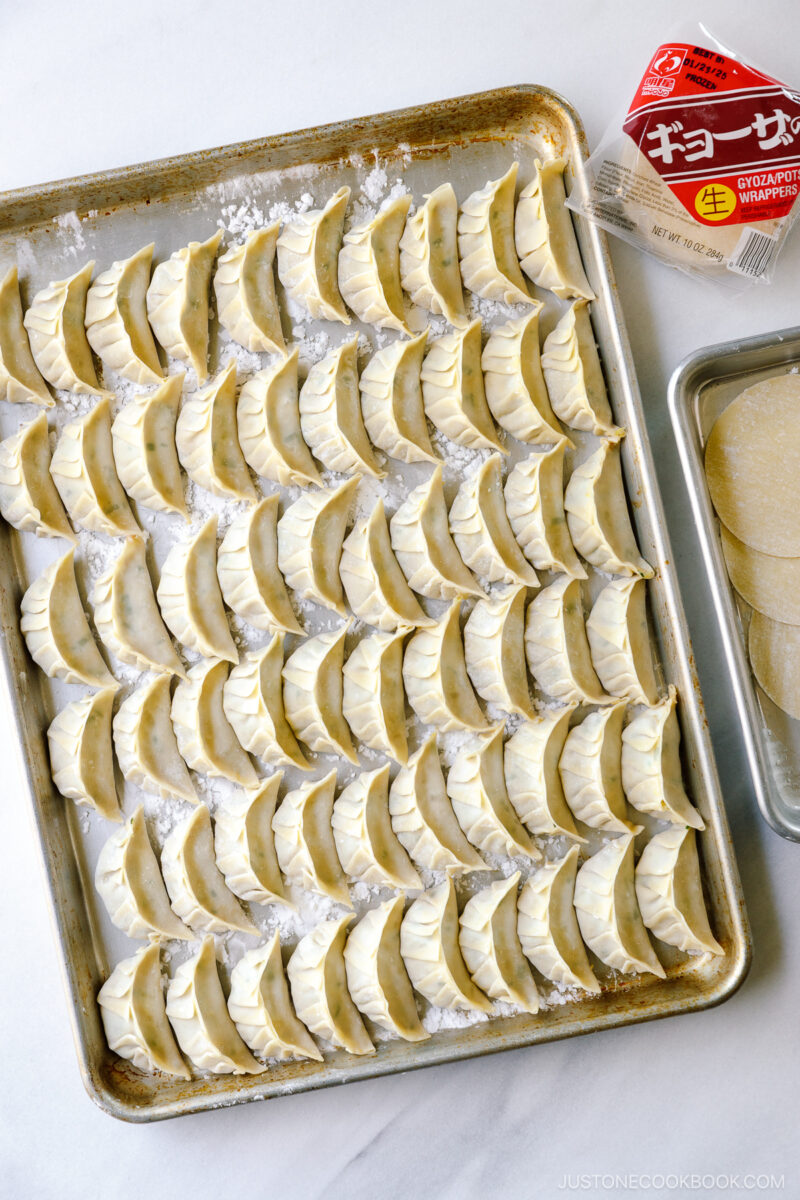

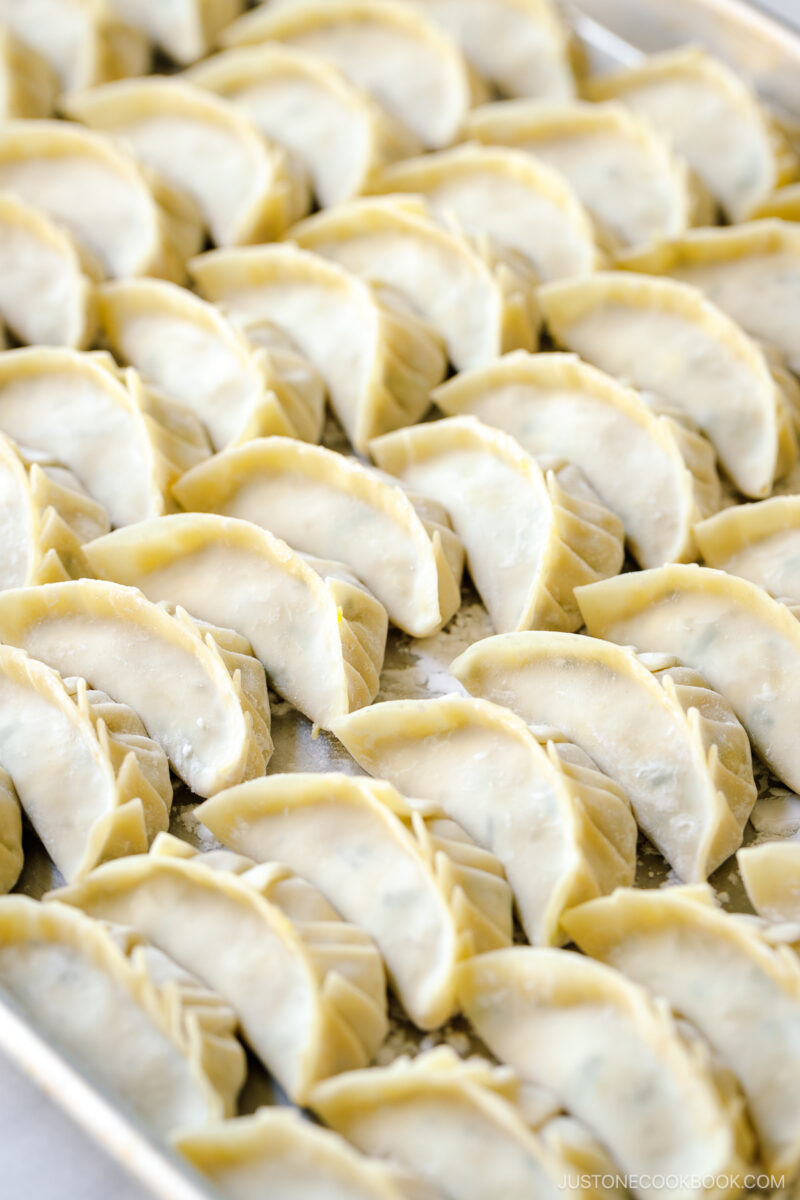

Ingredients for Napa Cabbage Gyoza
- Napa cabbage – In a pinch, you can use regular green cabbage.
- Ground pork – For vegan/vegetarian, substitute with mushrooms or tofu.
- Gyoza wrappers – If you can’t find them, make your gyoza wrappers!
- Aromatics: Garlic, ginger, and green onions
- Seasonings: Salt, sake, soy sauce, miso, and toasted sesame oil
- For frying: Neutral oil, toasted sesame oil, and water
- Optional miso dipping sauce: Miso, soy sauce, rice vinegar, sugar, and la-yu (Japanese chili oil)
How to Make the Best Napa Cabbage Gyoza
Detailed instructions can be found in the recipe card below. Here’s a quick summary.
- Make the gyoza filling: Mince the napa cabbage and sprinkle salt to withdraw moisture. Cut the garlic chives and green onions and combine them with the ground pork. Season the mixture and knead it well. Then, squeeze the napa cabbage to remove any moisture and add it to the meat mixture. Kneading the mixture once again.
- Fold the gyoza: I will show you detailed steps in the recipe card.
- Pan-fry the gyoza: Place the gyoza in the pan, flat side down. Fry until the bottom is brown, then add water to the pan, cover, and steam until the water has evaporated. Place the gyoza in the pan, flat side down. Fry until the bottom is brown. Then, add water to the pan, cover, and steam until the water has evaporated.
- Serve immediately with the optional dipping sauce.
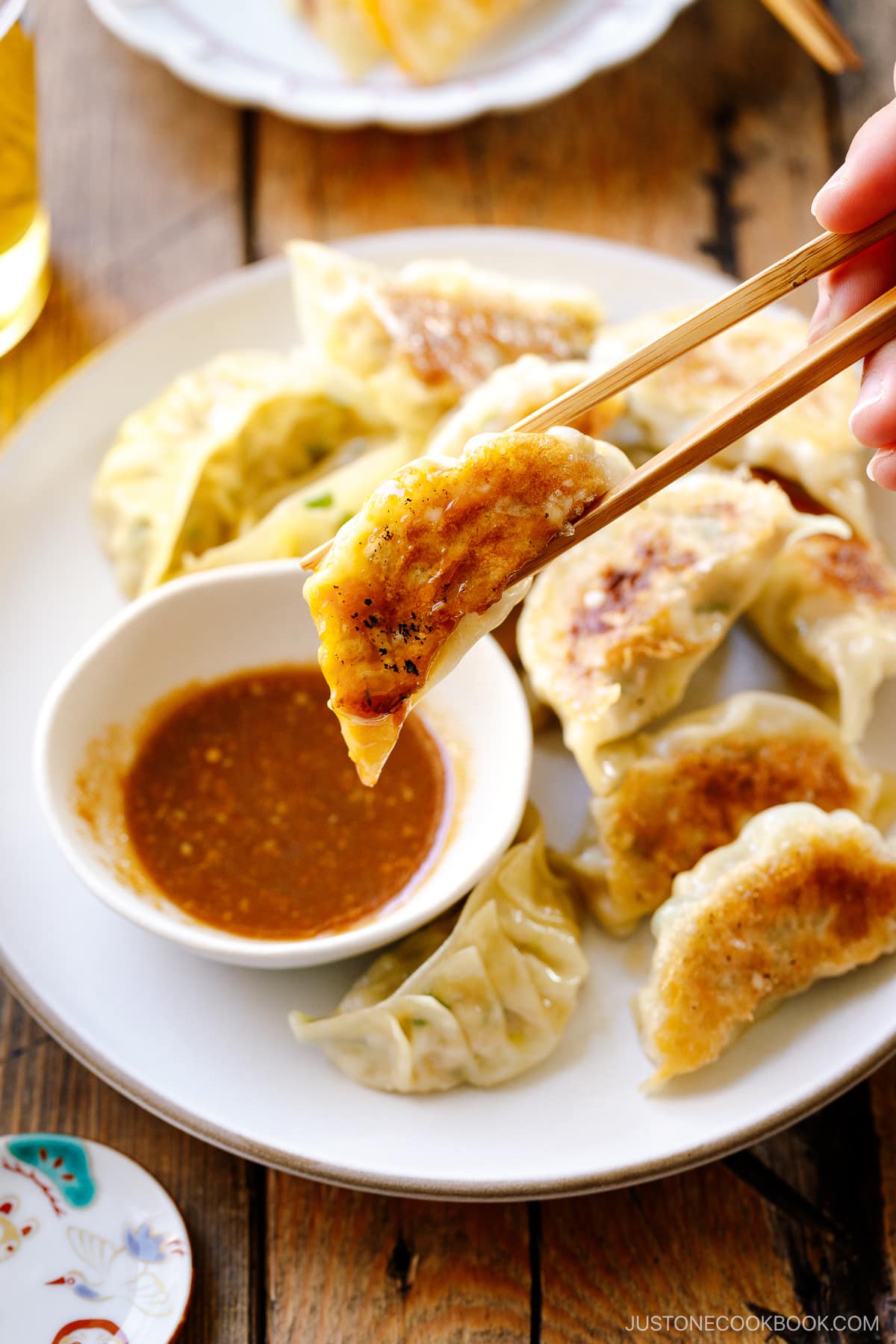

Substitutions and Variations
- Napa cabbage vs. green cabbage – You can use either one for gyoza. The main difference is the texture. Cabbage yields a firmer and substantial texture, while napa cabbage yields a soft and tender texture. Flavorwise, it’s quite similar but cabbage has a more pronounced flavor than the subtle napa cabbage taste.
- Different protein choice – Ground pork works best for gyoza, but you can substitute it with ground chicken or turkey. For vegan/vegetarian, mince different types of mushrooms (more flavor!), or/and crumble well-drained firm tofu, and then mix it with the rest of the vegetables.
- Garlic chives – When my kids were small, they thought garlic chives were too strong so I replaced them with more green onions. You can use just garlic chives, green onions, or a combination of both.
- Sake – In traditional Japanese cooking, you will notice we use sake when we use meat and seafood. Besides adding umami, sake helps remove unwanted smells from the meat/seafood. Alcohol evaporation takes away a gamey smell. If you don’t consume alcohol, simply omit it. Garlic and ginger also help remove the unwanted smell.
- Miso – For this recipe, I wanted to bring out more miso flavor so I used it in the filling and dipping sauce. If you don’t make the dipping sauce altogether, you can double the amount of miso in the filling. This way, you won’t need to dip the gyoza in any sauce, and they will still be plenty flavorful.
Recipe Tips and Techniques
- My meat-to-cabbage ratio is between 1:1 and 1:1.5. If you are curious, typical gyoza in Japan is 1:2 (yes, way more cabbage!). My family likes a bit more meat in the filling. Please adjust as you like and adjust the seasonings for the filling.
- Draw out moisture from the napa cabbage. This is very important so gyoza wrappers don’t get soggy from the moisture released from the napa cabbage.
- Knead the meat mixture until sticky, pale, and fluffy. This helps make the filling juicy and tender. Use these disposable gloves if you don’t want to knead with your bare hand.
- Use less than 1 tablespoon of gyoza filling. If you’re a beginner, start with a scant 3/4 tablespoon. I use a small OXO cookie scoop (1 Tbsp) and level off the filling. When I add more than 1 tablespoon, the filling squeezes out while making pleats.
- Best ways to fold gyoza: Please follow my step-by-step tutorial, which includes pictures and detailed tips.
- Cover your gyoza wrappers with a damp paper towel or kitchen cloth while folding. Once you open the package, the edges of the wrappers dry quickly. Covering helps keep them moist and easier to use.
- Freeze leftover gyoza wrappers or use them to make pan-fried cheese wraps (in the recipe card).
- Cook or store the dumplings soon after they’re wrapped. Even though you draw out moisture from the napa cabbage, the filling still contains some moisture, so don’t let gyoza sit on the counter for too long. Either pan-fry them quickly or flash-freeze them (more later).
Store-Bought or Homemade Gyoza Wrappers
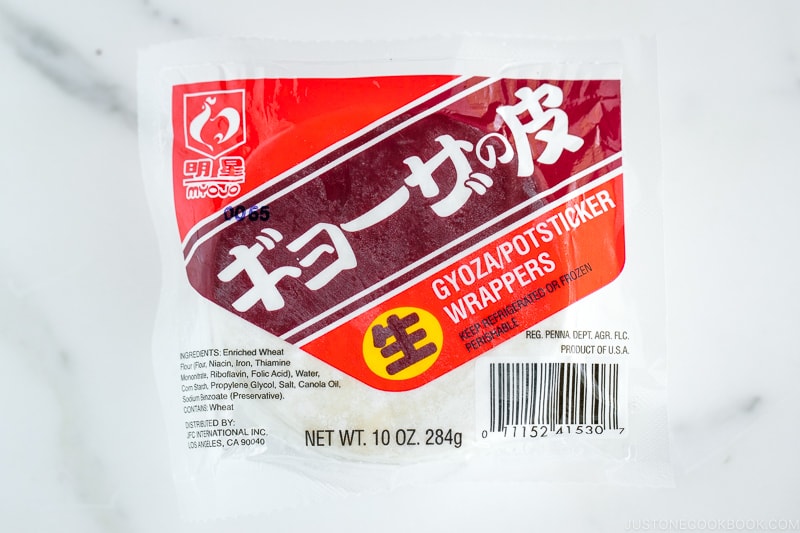

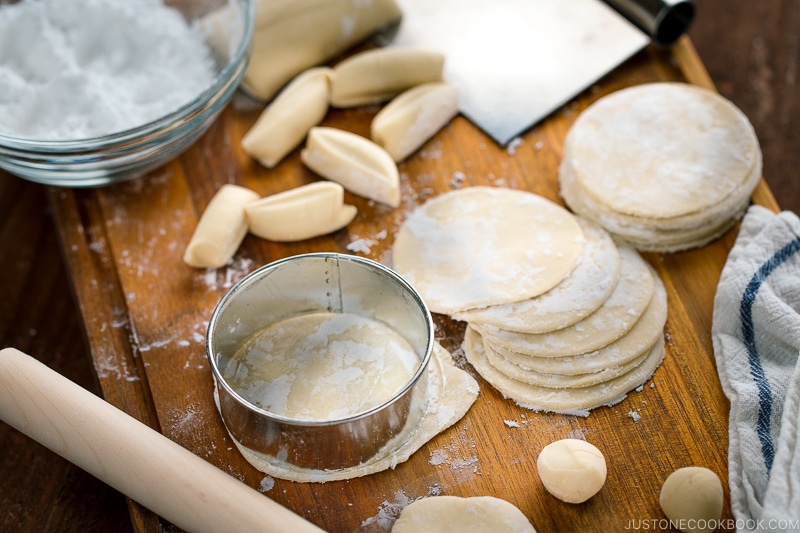

I use Myojo brand Gyoza wrappers that I get from the refrigerator or freezer section of the Japanese grocery store. Different wrapper sizes are available in Japan, but here in the San Francisco Bay Area, we have limited choices and the Myojo brand is easily accessible in Japanese and Asian markets. Unfortunately, they are perishable and not available online (but do check Weee!, an Asian grocery delivery service).
You can always make gyoza wrappers from scratch. It’s fun and quite satisfying to be able to make your own wrappers at home with just 3 ingredients – flour, salt, and water!
Delicious Miso Dipping Sauce
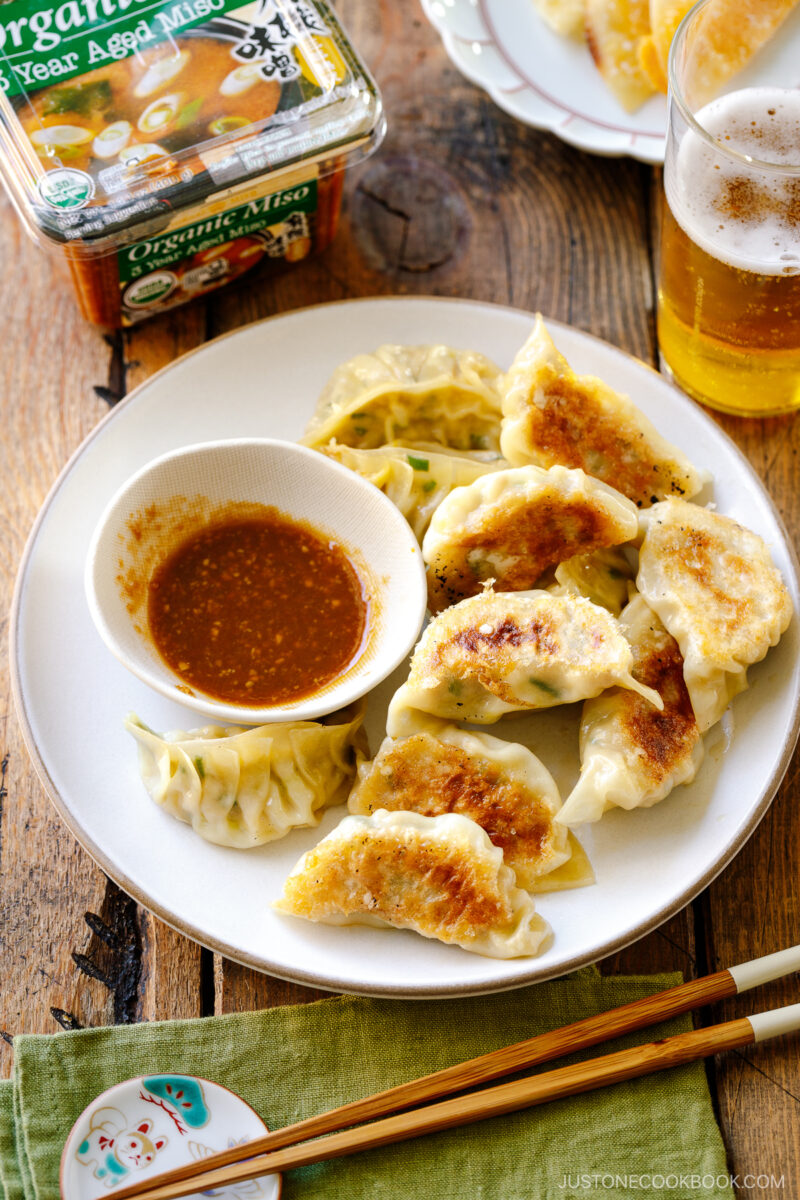

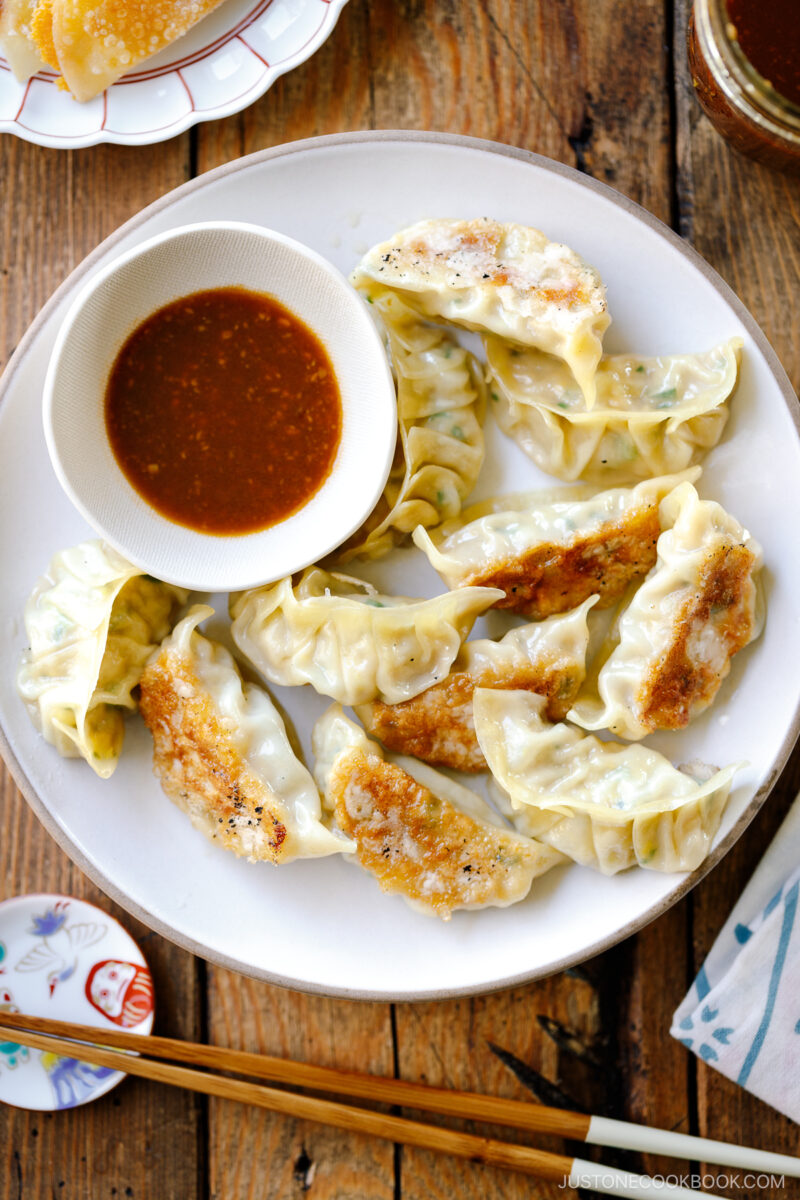

Gyoza is typically dipped in a mixture of soy sauce, rice vinegar, and la-yu, but I thought Kobe-style miso dipping sauce would complement these pan-fried dumplings. These napa cabbage gyozas are delicious on their own, but I highly recommend trying this sauce once. After all, dipping sauces make everything taste better!
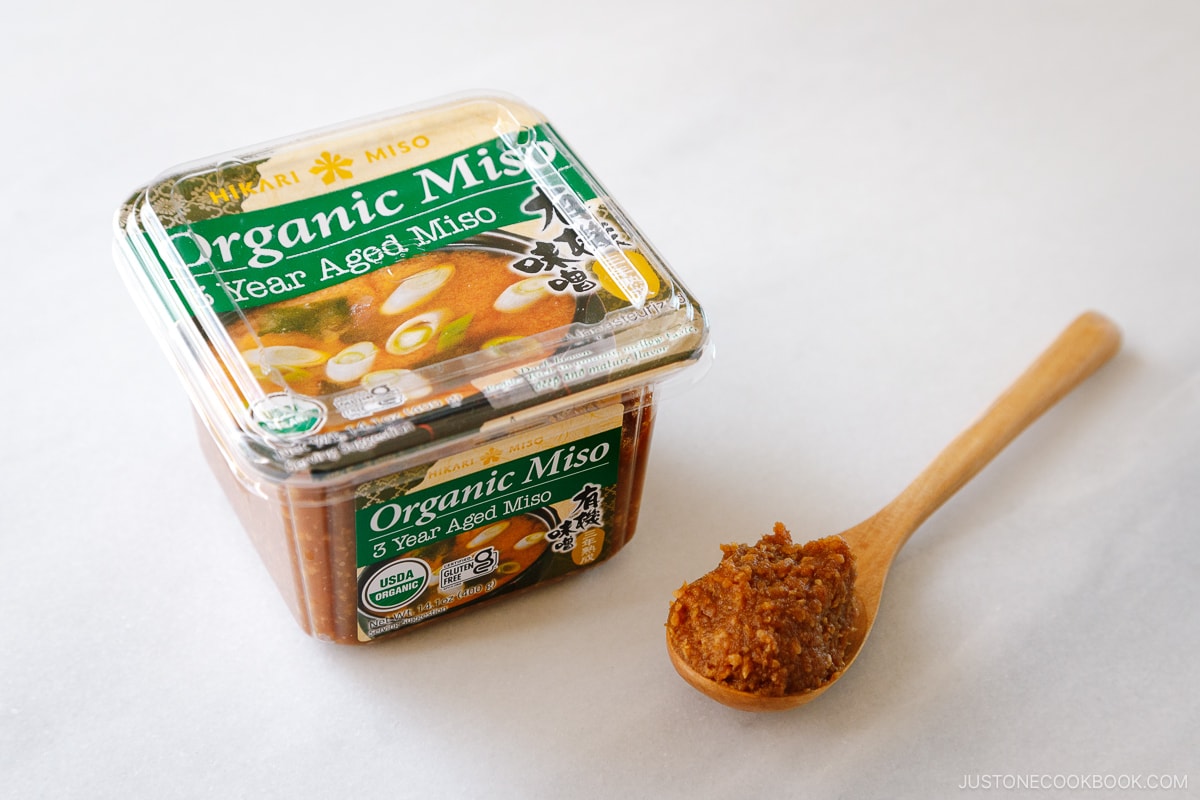

I used Hikari Miso’s 3 Year Aged Organic Miso for the gyoza fillings and dipping sauce. This premium miso is made from organic rice and soybeans, and it has strong umami and a complex fermented flavor. The richness goes well with gyoza, which use aromatics like garlic and ginger.
The dipping sauce is easy and simple to make, with ingredients including miso, soy sauce, rice vinegar, toasted sesame oil, and sugar. It’s slightly nutty, savory, and super umami—thanks to the addition of long-term aging miso. So delicious when you dip the dumplings into the sauce!
How to Store Gyoza
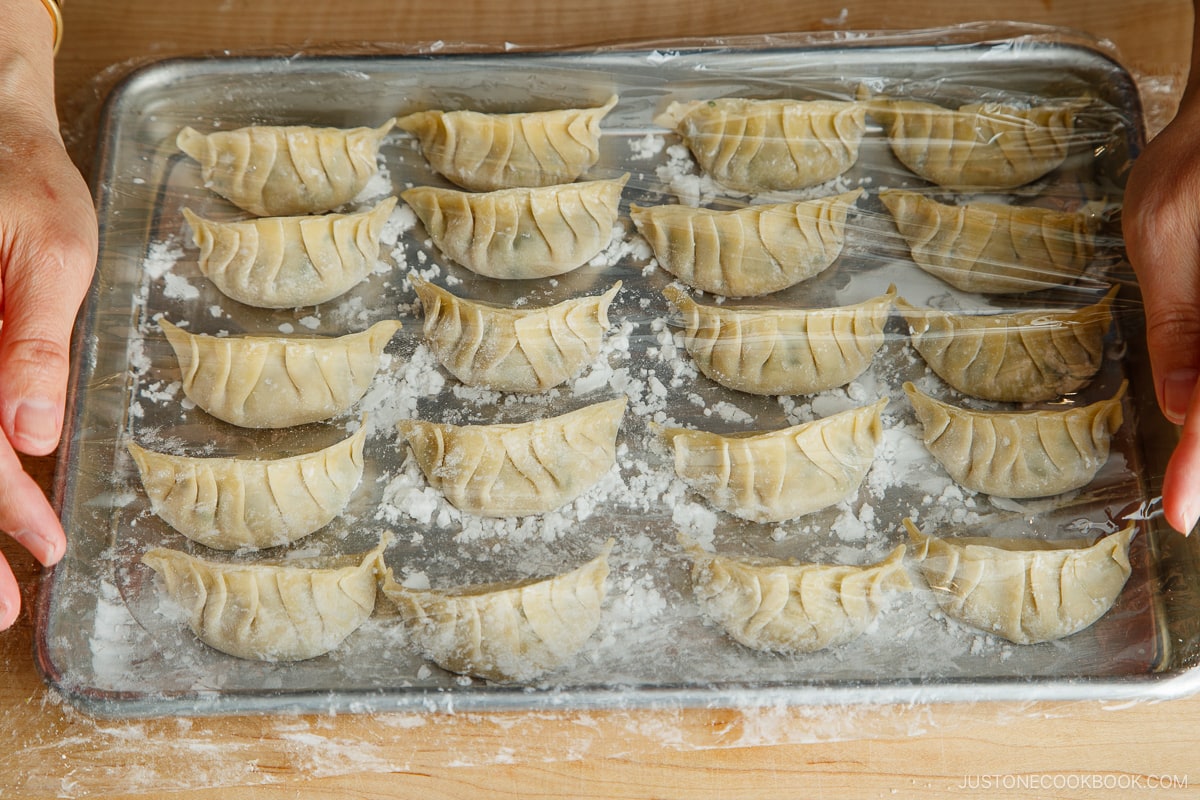

If you make a big batch, store the extra gyoza in the freezer before cooking them. Why don’t we cook them first and then freeze them? When you freeze gyoza after cooking, they lose their crispness and become too soft and soggy after reheating.
Arrange individual gyoza on a baking sheet and freeze them in a single layer spaced out. Then, transfer them into freezer bags. You can store them for up to 2–3 months in the freezer.
How To Cook Frozen Gyoza: Cook frozen gyoza without defrosting. Do not defrost! Cooking time is almost the same as freshly folded dumplings, so treat frozen gyoza the same way. You might need extra 1–2 minutes longer to brown the bottom of the gyoza before steaming.
What to Do with Leftover Wrappers
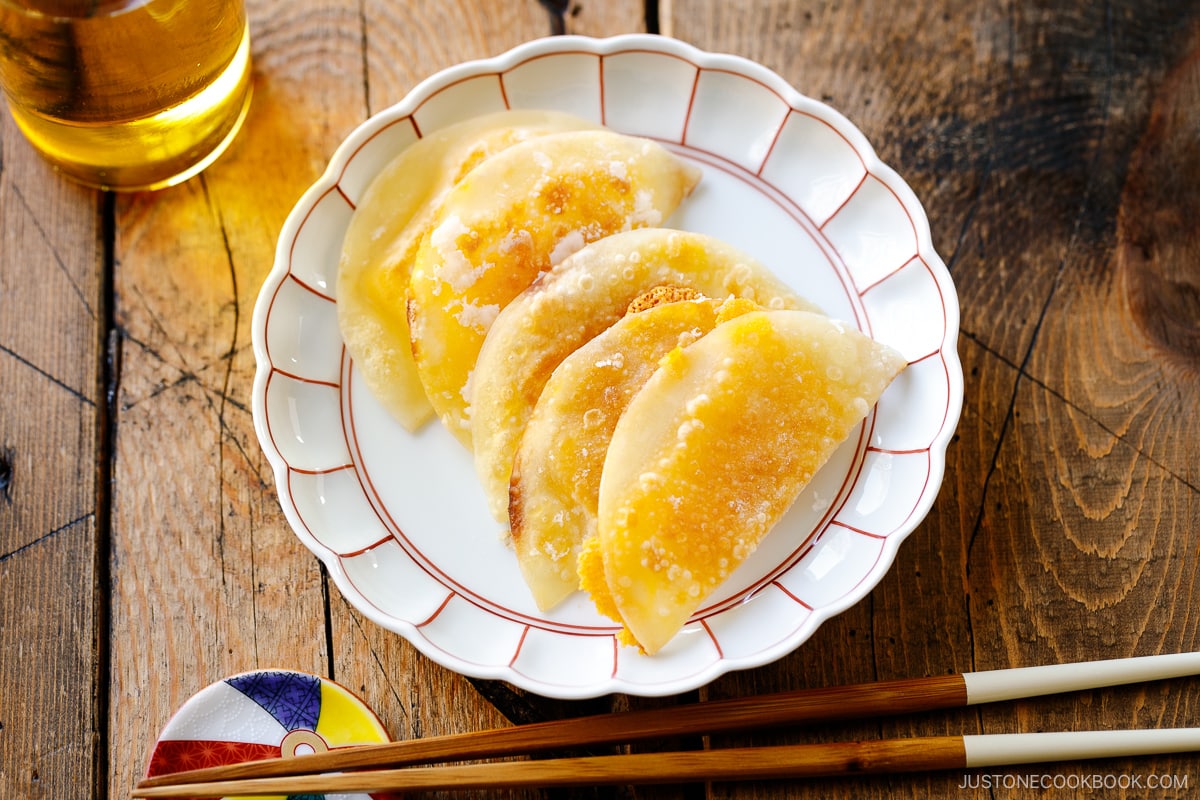

When you have leftover gyoza wrappers, make these crispy cheese wraps! They are so easy to make, and my kids love snacking on a few bites of these while waiting for dinner time. You can find the quick instructions in the recipe card below.
What to Serve with Napa Cabbage Gyoza
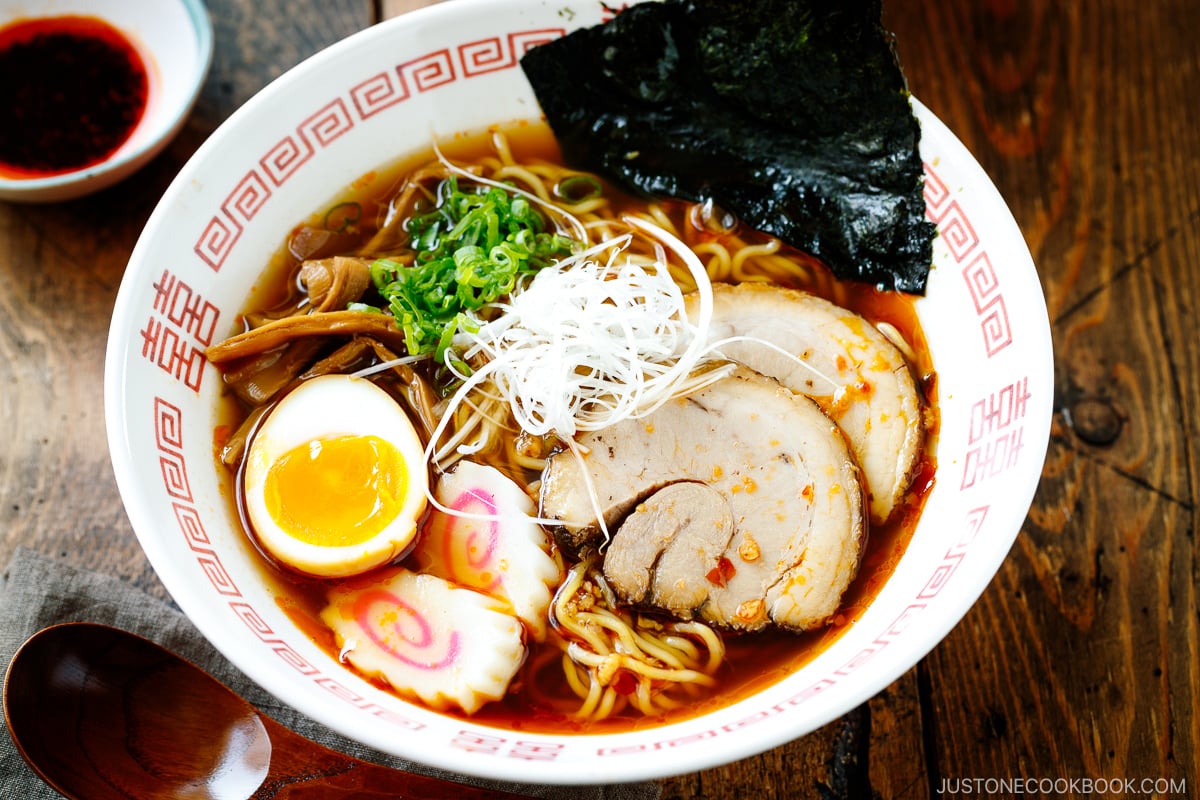

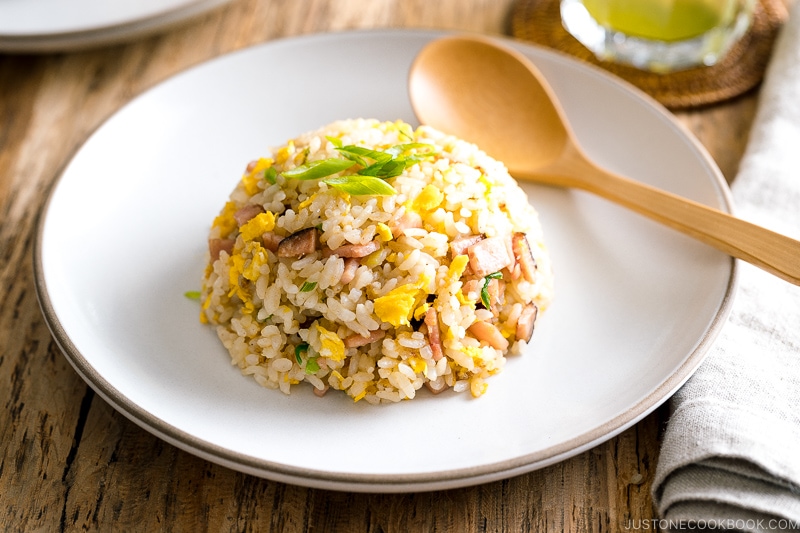

Gyoza dumplings are best served as an appetizer to your Japanese meal or a main dish. They are also a popular menu for an Asian-themed potluck! They can be served as a part of Chinese Japanese dishes (called chuka ryori) such as ramen and fried rice. I often include gyoza in my kids’ bento as well.
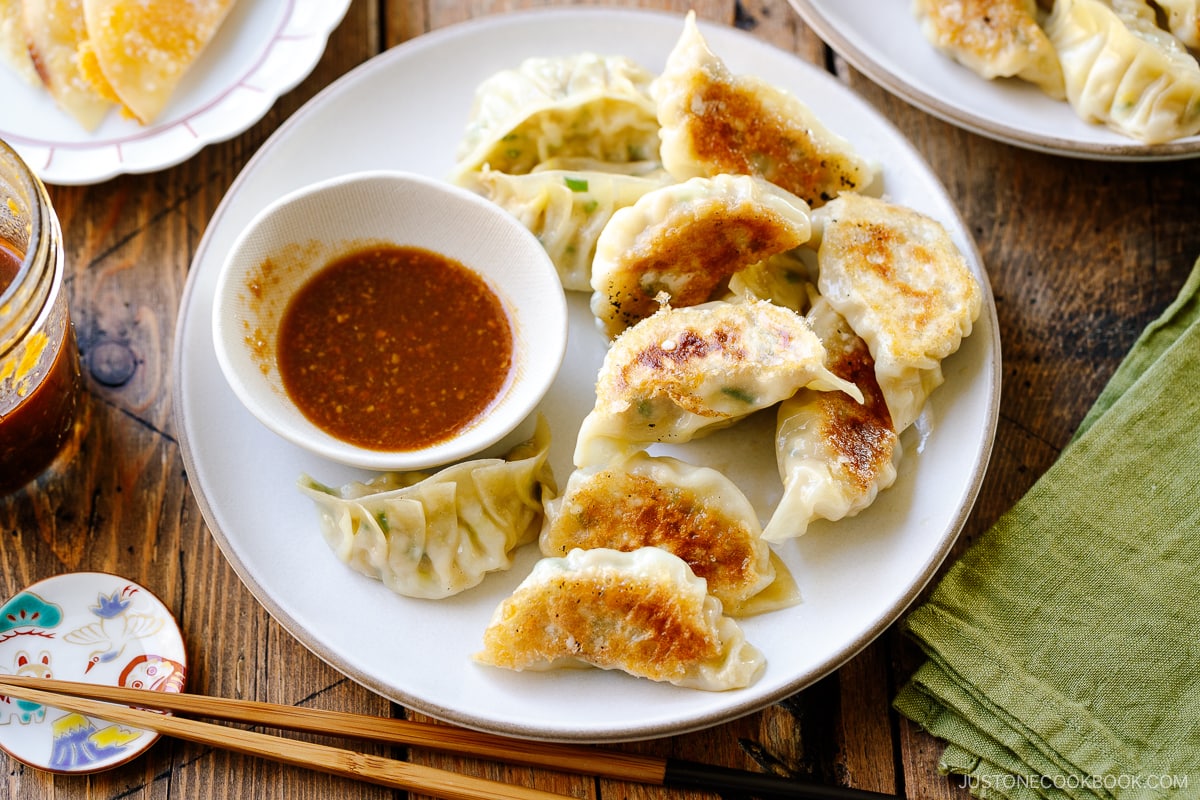

Wish to learn more about Japanese cooking? Sign up for our free newsletter to receive cooking tips & recipe updates! And stay in touch with me on Facebook, Pinterest, YouTube, and Instagram.
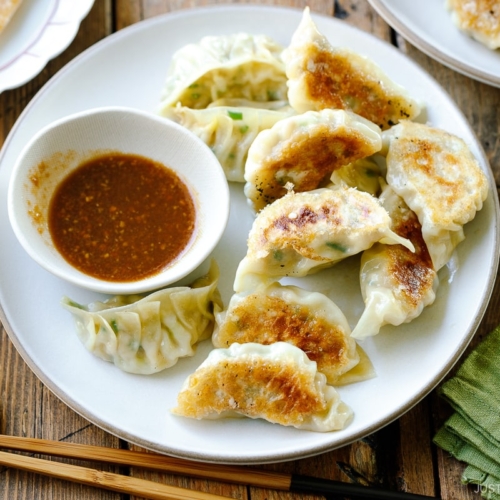

Napa Cabbage Gyoza with Miso Dipping Sauce
Get creative with your pan-fried dumpling filling in my crispy and juicy Napa Cabbage Gyoza with miso dipping sauce. Popular in Japanese cooking, mild and sweet napa cabbage perfectly complements the miso-seasoned pork in these aromatic potstickers.
Ingredients
For the Filling Seasonings
For the Miso Dipping Sauce
Prevent your screen from going dark
Instructions
To Prepare the Napa Cabbage
To Make the Filling
-
Meanwhile, slice 2 oz garlic chives (Chinese chives or Nira) into small pieces. Add to a large bowl.
-
Next, chop 2 green onions/scallions into thin slices and add to the bowl with the chives.
-
Peel a knob of ginger and grate it (I use a ceramic grater). Measure 1 tsp ginger (grated, with juice).
-
To the bowl, add 1 lb ground pork, 1 clove garlic (crushed; I use a garlic press), and the grated ginger. Then, add the seasonings: 1 Tbsp sake, 1 Tbsp miso, 1 Tbsp soy sauce, 1 Tbsp potato starch or cornstarch, 1 Tbsp toasted sesame oil, and ¼ tsp freshly ground black pepper.
-
Mix well and knead the mixture with your hand (I wear a plastic glove) until it becomes sticky and pale in color.
-
Use your hands to squeeze out the moisture from the wilted napa cabbage. Look how much liquid the napa cabbage released!
-
Add the drained napa cabbage to the meat mixture. Knead well by hand to combine until the cabbage is evenly incorporated into the filling and the mixture is sticky.
To Fry the Gyoza
-
Cook the gyoza in batches. First, heat a large frying pan over medium heat; nonstick or carbon steel pans work well. When the pan is hot, add 1 Tbsp neutral oil. Then, place the gyoza in the pan, flat side down. Arrange them in a single layer in either a circular pattern or two rows, and leave space between each piece so they don‘t touch each other.
-
Cook until the bottom of the gyoza turns golden brown, about 3 minutes. Then, add 4 Tbsp water to the pan.
-
Immediately cover with a lid and steam the gyoza for about 3 minutes or until most of the water evaporates. They are cooked if the gyoza pleats look soft; if not, add some water and steam for a bit longer. Tip: If you‘re cooking frozen gyoza, steam them for an extra 1–2 minutes.
-
Remove the lid to evaporate any remaining water.
-
Drizzle ½ Tbsp toasted sesame oil around the edges of the pan. Cook, uncovered, until the gyoza are browned and crisp on the bottom. Since I use a carbon steel pan, I have to make sure the bottoms of the gyoza have a nice crust, otherwise they will stick and won‘t come off clean.
-
Once the gyoza have a crust, they will release from the pan naturally. Remove to a plate. Repeat this process to cook the other batches.
-
For the cheese filled wrappers (optional), simply pan-fry both sides in neutral oil until golden brown.
To Serve
-
In a small bowl, combine the ingredients for the dipping sauce: 3 Tbsp miso, 3 Tbsp soy sauce, 3 Tbsp rice vinegar (unseasoned), 1 Tbsp sugar, and ½ Tbsp la-yu (Japanese chili oil).
-
Transfer the Napa Cabbage Gyoza to a serving plate and serve with individual bowls of miso dipping sauce on the side. Enjoy!
To Store the Cooked Gyoza
Editor’s Note: This post was originally published on April 18, 2011. It was republished with a revised recipe, new step-by-step and final images, and more content and helpful tips on March 26, 2024.

